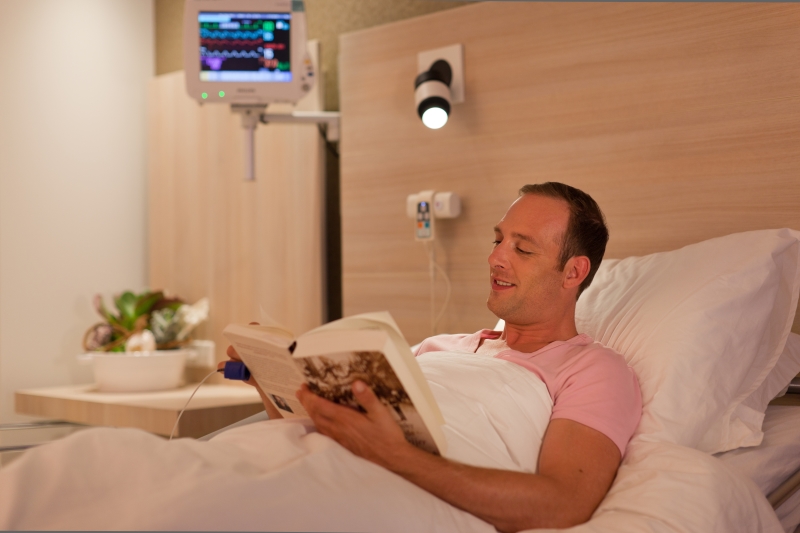In the past decade hospital design has seen a major shift – from multi-bed hospital wards to single patient rooms.
And this change of direction is impacting on the specification of many building materials and fixtures and fittings.
Single-room patient environments have driven greater lighting customisation and can now assist patients with different conditions, care teams by enabling faster room-illumination, and even support the specific needs of an individual hospital
Lighting is one area that has seen a number of changes.
Speaking to BBH, Henri Juslén, a chief future illuminator at lighting manufacturer, Helvar, explains: “In an attempt to limit risk of infection, and enhance the patient experience; single patient rooms are now dominating hospital design.“While these rooms create a comfortable space, offering privacy and aiding recovery; the range of patient needs creates a challenge when specifying lighting solutions.”
Key drivers for single room solutions include ease of use and the ability to control lighting levels and other room features, usually by remote control.
Juslén said: “Patients in acute care rooms are often in a condition where controlling lights might be difficult and learning how to control them is not top of their priority list.
“While some may need voice control, others may want to adjust everything according to their needs, for example by using a tablet or smartphone.
“No matter how the lighting is controlled, research overwhelmingly tells us that it matters.”
Franka Grosse, director of the global healthcare business at Signify, formerly Philips Lighting, added: “Single-room patient environments have driven greater lighting customisation and can now assist patients with different conditions, care teams by enabling faster room-illumination, and even support the specific needs of an individual hospital.
“New, more-dynamic lighting recipes can support patients’ biorhythms during the day and have a proven positive effect on sleep cycles and increased comfort and satisfaction which assist with patient recovery and assist staff, who often have irregular working patterns.
As hospitals deal with a mass of diverse patients daily, the building design simply cannot provide individual accommodation for all who stay. So using lighting controls in large, communal hospital wards can limit the negative effects
“And new, modern lighting systems also allow patients and staff to control individual settings for extra comfort and atmosphere creation.
“For staff, high levels of functional light creates a better working environment for tending to patients and performing tasks.”
But multi-bed hospital wards have not been completely phased out, and lighting solutions for these environments are also evolving.
“It is unpleasant to be disturbed in the middle of the night because another patient requires lighting to use the bathroom or receive emergency treatment,” said Juslén.
“These disturbances, while unavoidable in round-the-clock patient care, can have an impact on the patient experience as a whole.
“The task of modern lighting controls is to limit these disturbances so that each patient feels they have their own space while using a shared space.
“Lighting solutions in multi-patient wards should, therefore, be zoned in a way that the lighting at one bed can be blocked from disturbing others.
“Automation should take care of fine tuning the lights and sensor parameters in a way that accidental light bursts would happen very rarely.”
Grosse adds: “Modern lighting systems, like Philips HealWell, can be installed as a standalone system or as part of an overall hospital campus networked lighting system.
“Clearly single-room environments allow for more personalised lighting. This could be light settings to aid waking in the morning, to reflects moods, or create different ambiances throughout the day. They can also be used to perform specific functions, like aiding reading, or to ensure a patient follows their natural circadian rhythms.

Philips HealWell lighting has become a leading choice for hospitals
“And settings can be created to reflect patient preferences across a whole day, or to aid clinicians in patient care.
Philips HealWell technology is evidence based, aligning lighting levels and tones automatically with the human circadian rhythm, which can be personalised by colour, to help hospital patients sleep better, feel happier, and heal faster.
“Nurse panels and switches let staff control lighting for each bed and illuminate rooms quickly as needed. It also provides excellent visibility for staff when needed for important or emergency medical examinations”, said Grosse.
Bradford Royal Infirmary is currently working with Signify to enhance environments for people with dementia, using bright ambient lighting during the day so that patients are encouraged to stay awake and so sleep better at night.
In the future, digitalisation and connectivity will increasingly be key drivers in new lighting solutions for hospital environments.
Grosse predicts: “To increase the patient experience and support decision-making, as well as improving efficiencies and therefore costs; IoT lighting will become much more popular.
The task of modern lighting controls is to limit disturbances so that each patient feels they have their own space while using a shared space
“This will offer more insights in building usage and therefore space optimisation.
“The latest lighting-based indoor navigation systems will also enhance patients and visitors’ experiences via simple-to-use mobile apps.”
Juslén concludes: “As hospitals deal with a mass of diverse patients daily, the building design simply cannot provide individual accommodation for all who stay. So using lighting controls in large, communal hospital wards can limit the negative effects.
“The end goal is to light hospitals so that every patient feels comfortable and well supported in a private space that they can adjust to suit them.”
